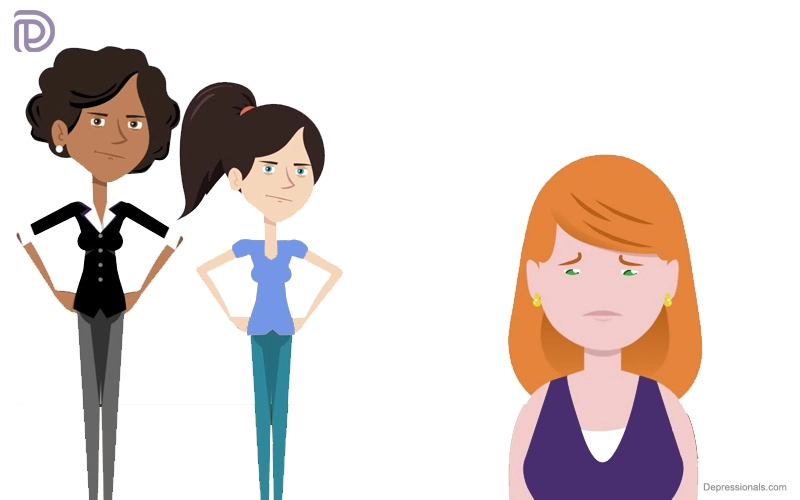What is borderline personality disorder (BPD)?
Borderline personality disorder (BPD) is an extremely serious mental disorder marked by severe mood swings, emotional instability and erratic behavior. The American Psychiatric Association (APA) recognizes it as one of several types of personality disorder.
When left untreated, personality disorders can cause great distress. These disorders usually begin in late adolescence or early adulthood and continue over the course of many years. BPD can be significantly treated with the right treatments.
Read: 17 Signs of Materialistic Person
Difference between borderline personality disorder and bipolar disorder
Borderline personality disorder (BPD) and bipolar disorder are both characterized by mood and behavior fluctuations.
Bipolar disorder is characterized by rapid mood swings and less reactive behavior, especially when interacting with others, while BPD moods are sustained and less reactive when confronted with significant stress. The energy levels and activity levels of bipolar disorder patients also fluctuate significantly.
Who does borderline personality disorder affect?
The majority of personality disorders develop during the teenage years when your personality continues to develop and mature. Therefore, borderline personality disorder is almost exclusively diagnosed in people over 18 years old.
BPD can occur to anyone, but those with a family history are more likely to develop it. The risk is also higher for people with anxiety disorders, depression, and eating disorders.
It is estimated that 75% of people who suffer from BPD were assigned female at birth (AFAB). Researchers suggest that AMBs may also suffer from BPD, but they may be mistakenly diagnosed with PTSD or depression.
Borderline personality disorder symptoms
The effects of BPD could interfere with your ability to lead a fulfilling life or succeed at work, school, or in relationships. Problems with interpersonal relationships, emotions, self-image, behavior and thinking are common, including:
Behaviors
The symptoms of BPD can include excessive alcohol consumption or drug abuse, risky intimate moments, or binge eating. These behaviors are associated with risky and impulsive behaviors common in BPD. Moreover, people with bipolar disorder are more likely to cut themselves, burn themselves, and attempt suicide.
Emotions
Instability of emotion is a key aspect of BPD. Individuals feel as if they’re on an emotional rollercoaster with rapid mood swings (i.e., feeling okay one minute then feeling down the next). A mood change may last minutes or even days, and it may be intense. There is also a common sensation of anger, anxiety, and feeling drained.
Read: Signs of Self-Obsessed Person
Relationships
People with BPD often have conflicted, argumentative, and strained relationships with their loved ones. BPD can be characterized by a fear of abandonment by loved ones and by attempts to avoid that abandonment. Usually, this causes a strain in relationships, as it makes it difficult to trust others.
Self-image
BPD patients have difficulties maintaining their sense of self. How they feel about themselves goes through many ups and downs. Some feel good about themselves at one moment, and other times they feel bad or evil.
Read: Immature Personality Disorder
Stress-related changes in thinking
Stress may cause BPD sufferers to experience paranoid thoughts (for example, the belief that others want to harm them) or dissociation (numbness, floating, or feeling as if they don’t belong in their bodies).
There are not all BPD symptoms experienced by everyone. The symptoms may vary from person to person; others may experience most of them.
What causes borderline personality disorder

It is unknown exactly what causes BPD, as is true for the majority of psychological disorders. Researchers note that there is some evidence to suggest that nature (genetics or biology) may play a role as well as the environment.
Your risk may be influenced by these contributing factors:
Brain structure
It is known that people with BPD have differences in brain structure and function, particularly in areas of the brain related to impulse control and emotional regulation. However, it’s still unclear whether these differences are caused by or related to BPD.
Read: Impulse Control Disorders
Family history
It is also possible to develop BPD if a parent or sibling has the condition.
Negative experiences
Most people diagnosed with BPD were abused or neglected as children or were separated from caregivers at a young age. BPD is not present in all people who experienced such a childhood event and, conversely, not all people with such a history develop BPD.
The presence of a risk factor is not synonymous with its cause; just as people without risk factors can develop the disorder, those who do can as well.
Check: Types of Overthinking
Diagnosis
The diagnosis of BPD involves evaluating the symptoms of an individual and reviewing their medical history. To rule out medical illnesses that may be contributing to the symptoms, your doctor may also perform a physical exam and laboratory tests.
Symptoms of BPD must be present in at least five different contexts for a diagnosis to be made:
- Efforts to prevent abandonment
- Emotional instability
- Feelings of emptiness
- Identity disturbances
- Impulsive behaviors
- Anger that is excessive and inappropriate
- Unstable interpersonal relationships
- Self-harm or suicide attempts
- Symptoms of paranoia or dissociation
Mental health conditions that can cause similar symptoms will also be ruled out by a doctor or therapist. The following disorders may be classified as bipolar disorder, narcissistic personality disorder or histrionic personality disorder.
To get support and assistance from a trained counselor if you are experiencing suicidal thoughts, call the National Suicide Prevention Lifeline at 1-800-273-8255. Call 911 if you or someone you love is in immediate danger.
See our Helpline Database for more mental health resources.
Borderline personality disorder treatment
Researchers have shown that BPD can be treated to a great extent, despite expert opinions to the contrary. You can live a more fulfilling life with fewer symptoms if you receive regular treatment from a mental health professional.
In theory, BPD treatment would also stop self-harm, suicide, and risky behavior. You will need treatments specifically tailored to treating BPD, so you should seek out a specialist. It may not be as effective if you don’t get the right treatment.
In general, the following options are offered:
- Psychotherapy: BPD is treated with this method. Mentalization-based therapy (MBT) and dialectical behavior therapy (DBT) are among the types of psychotherapy that are appropriate for BPD patients. You could include friends, family or caregivers.
- Medication: Certain symptoms such as depression, mood swings,or anxiety may also be treated with borderline personality disorder medication by a mental health professional.
- Other treatments: It may be necessary to hospitalize or receive intensive treatment during times of crisis.
The symptoms of BPD can include impairments in a variety of areas, such as work, school, relationships, and legal status, which is why treatment is so crucial. When people with BPD follow their treatment plans as prescribed, they can live fulfilling, normal lives despite the obstacles caused by BPD.
Recommended: How to help someone with Depression
Coping
You can improve your functioning and cope with BPD by taking measures that will help you. These steps can help you live a healthier life:
Get appropriate treatment
You should seek out professional care from a licensed mental health professional if you think you or someone close to you may have BPD, such as a mental health counselor, social worker, psychologist, or psychiatrist.
Diagnose your condition accurately
There is no reason to believe that BPD is a rare disorder since many symptoms are common to everyone. There are also some similarities between BPD symptoms and those of other mental and physical disorders. BPD can only be diagnosed by a licensed professional
Read: How to Deal With a Narcissist
Develop a treatment plan with your doctor or therapist
There is hope after a diagnosis is made. Depending on the situation, a therapist or doctor may suggest psychotherapy, medications, or other treatments.
Maintain a treatment plan
Treatment of BPD symptoms can significantly reduce symptoms. After continuous and good treatment, some people once diagnosed with the disorder no longer fit the criteria for clinical diagnosis.
Though the reasons are not clear, some people are starting to notice improvements around the age of 40, when the symptoms of BPD tend to decrease.
Recommended: Multiple Strategies to Control Overthinking
What can I do to help someone with borderline personality disorder
Here are some ways to help a friend or loved one with borderline personality disorder
- Learn about BPD so you can better understand what your loved one is going through.
- Family therapy might be an option if your relative has BPD. Encourage your loved one to seek treatment.
- Support, understand, and be patient with others. BPD sufferers can be frightened by change, but their symptoms can improve with treatment over time.
- Symptoms of mental health conditions, such as anxiety or depression, should be treated by therapy if you’re experiencing significant stress. Your loved one may benefit from seeing a therapist who is different from the one they currently see.
Suicidal behavior and self-harming are significantly more common among people with BPD. It is important to get help as soon as possible for people with BPD who have thoughts of harming themselves or attempting suicide.
Can BPD lead to complications?
You are more likely to develop other disorders if you have BPD, including:
- Depression
- Anxiety disorders
- Eating disorders
- Bipolar disorder
- Substance abuse
- Post-traumatic stress disorder (PTSD)
- Attention-deficit/hyperactivity disorder (ADHD)
- Other personality disorders
There are many aspects of your life that can be affected by borderline personality disorder. Negative effects may include: the adverse effects of depression on intimate relationships, jobs, schools, social activities, and self-image, as well as:
- Work problems
- Relationship problems
- Abusing someone, either as a victim or abuser
- Infections transmitted through intimate contact
- Self-injury
- Suicide
- Accidentally crashing your vehicle
- Fights between people
- Victims of violent crimes
Read: Major Effects of Bullying on Mental Health
What are the outlooks for people with BPD?
BPD patients have a varied outlook on life. The effects of BPD could last a lifetime. Suicidal thoughts and self-harm may haunt you at times. It is important to follow your doctor’s treatment plan. A healthy lifestyle can help you live a safe and fulfilling life and reduce your symptoms.






Hi my loved one! I wish to say that this article is amazing, great written and include almost all significant infos. I’d like to peer extra posts like this.
This website online is really a stroll-by way of for all the info you wanted about this and didn’t know who to ask. Glimpse here, and you’ll positively discover it.